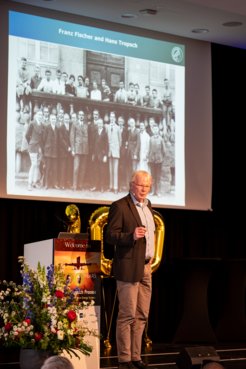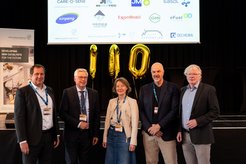Invented in Mülheim – Adopted Worldwide
Celebrating 100 Years of the Fischer-Tropsch Synthesis with an International Congress in Mülheim
Bringing science and industry together - that is the aim of DECHEMA, the Society for Chemical Engineering and Biotechnology, which has now organised a major international conference in Mülheim together with the MPI for Chemical Energyconversion, the MPI für Kohlenforschung and Syngas Conference to mark a special anniversary. The aim was to celebrate a chemical reaction that was discovered 100 years ago at the former Kaiser-Wilhelm-Institut für Kohlenforschung and is more relevant today than ever before: the Fischer-Tropsch synthesis.

Developed in the 1920s by institute director Franz Fischer and his colleague Hans Tropsch, the process was originally designed to produce liquid fuels from coal. However, it proved so fundamental that the reaction has been continuously refined and successfully applied around the world over the decades. In the context of the energy transition, the Fischer-Tropsch synthesis is more topical than ever, as it could be used to make aviation and maritime transport more climate-friendly – sectors that are notoriously hard to electrify. The conference explored all these aspects and opened with a historical overview by Ferdi Schüth, Director at the Max-Planck-Institut für Kohlenforschung.
“The feedstocks for Fischer-Tropsch synthesis have changed over the decades. While it began with coal, the process moved on to oil, then natural gas, and now to carbon sources from CO₂ or biomass,” explained Schüth. He took the audience on a journey through time, describing the state of chemistry in the 1920s, when foundational processes like the Haber-Bosch-process had already been discovered, but analytical chemistry was still in its infancy. “There were earlier methods for producing liquid hydrocarbons, such as those by Paul Sabatier (1902) or Mittasch-Pier-Winkler at BASF (1913), which were known to researchers in Mülheim. However, very few analytical tools were available to efficiently study catalytic processes,” Schüth noted. Despite these limitations, Fischer and Tropsch conducted experiments at the Mülheim institute that led to a breakthrough in 1925. On September 14 of that year, the patent for the Fischer-Tropsch synthesis was filed.
Fischer-Tropsch Over the Years – A Globally Versatile Process
After the patent was granted, Fischer-Tropsch production plants were built in Germany, with capacities reaching up to one million metric tons of gasoline per year. Economically, however, the Bergius-Pier process was more significant at the time. Still, the Fischer-Tropsch synthesis was adapted and extensively used in countries like South Africa. Denzil Moodley from Sasol, a South African company, reported how the firm has employed the synthesis in new reactors, using new feedstocks and catalysts over the years to produce paraffins, naphthenes, olefins, and other products. The shift to gas-to-liquids technology gave the process renewed momentum, and now, according to Moodley, the integration of renewable energy sources is perhaps the most critical topic of recent years.
Fischer-Tropsch for a Green Future – Economic Viability Is Key
Walter Leitner, Director at the MPI for Chemical Energy Conversion, emphasized the potential of the Fischer-Tropsch process for the energy transition: “The focus is now on products like e-fuels, which can be produced using renewable energy and used, for instance, to power ships and airplanes. Fischer-Tropsch is ideally suited for producing e-fuels from biomass or CO₂ – preferably captured from industrial emissions.” However, Leitner also highlighted several unresolved questions for the future: Can e-fuels be produced economically using Fischer-Tropsch? How can product yield be optimized? And can by-products be effectively utilized? He pointed out that moving away from fossil resources could give rise to entirely new value chains. “We chemists can design all the processes needed for the energy transition,” he said. “But to implement them, all stakeholders – investors, developers, and producers – need reliable regulatory frameworks. In the end, only economically viable solutions will prevail.”
“On the road to the energy system of the future – let a thousand flowers bloom,” said Ferdi Schüth. “And the Fischer-Tropsch synthesis is one of them.” The conference in Mülheim clearly demonstrated that this reaction has great potential – a potential that has already been harnessed over the past 100 years.

from left: Dr. Andreas Förster (Geschäftsführung DECHEMA e.V.), Prof. Dr. Walter Leitner (Direktor Max-Planck-Institut für Chemische Energiekonversion), Unni Olsbye (University of Oslo), Michael Claeys (University of Cape Town, Südafrika), Prof. Dr. Ferdi Schüth (Max-Planck-Institut für Kohlenforschung, Mülheim).














